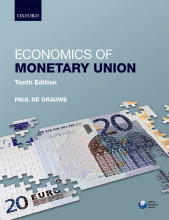Monetary Policy of the European Central Bank
20 important questions on Monetary Policy of the European Central Bank
Name four functions of the Eurosystem
2. conducting foreign exchange operations
3. holding & managing official foreign reserves of EU member states
4. promoting smoothing operation of payment systems
The ECB comprises 3 decision making-bodies. Name them and provide their main characteristics.
2. Executive Board contract term = 8 years. It prepares the meetings of the Governing Council and implements the MP decisions
3. General council discusses MP issues and their exchange rate relations with the euro
The ECBs primary objective is price stability. What is the so-called second plan?
- Higher grades + faster learning
- Never study anything twice
- 100% sure, 100% understanding
What is price stability, why is it important?
Important because:
1. price stability easens price comparisons, allowing markets to allocate resources more efficiently
2. price stability assures creditors stable prices: they will not demand an inflation risk premium
3. inflation/deflation worsens the perverse incentives of tax & welfare systems that distort economic behaviour
4. unexpected inflation causes arbitrary redistribution of wealth & income (poor suffer the most)
On which two pillars is the ECBs monetary policy based? Describe them.
- non-monetary analysis of the risks to price stability
- focus on assessment of current economic & financial developments and financial variables. Macroeconomic staff projections are used to assess price stability risks.
- identify nature of shock hitting the economy, their effects on cost & pricing behaviour
Monetary analysis (long-run) - discussion of monetary factors as a mean of cross-checking the short- to medium run indications of economic analysis
- focus on long run examining the liquidity situation
why two pillars? > to ensure that MP does not overlook relevant info for assessing future inflation trends
Through which channels do monetary policy decisions affect the real economy & inflation?
2. credit channel (bank lending, balance sheet, risk-taking)
3. exchange rate channel
4. expectations channel
Interest rate decisions are based in the 2 ECB's standing facilities. Describe them.
deposit facility: mops up liquidity from banks at rates normally well below market rates
> both have an overnight maturity & are available to banks on their own initiative
> banks only use these if there are no alternatives because the r are less favourable than the market rate
Explain open market operations and name some
! If assets are bought from a bank, the bank's reserves at CB increase
open market operations:
1. Main Refinancing Operations (MROs)
2. Longer-Term Refinancing Operations (LTROs)
3. Fine Tune Operations (FTOs)
Lending normally occurs through reverse transactions. What are they?
Who makes monetary policy decisions and who implements them?
Explain minimum reserve requirements and how they are used
Interest rates are stabilized by allowing banks to use averaging provisions. With these, banks can make profit from lending in the market and run a reserve deficit when the money market rates are above those expected.
At the end of the maintenance period, the reserve requirement becomes binding & banks can no longer transfer a liquidity surplus or deficit > explains spikes in the EONIA
Describe the 4 phases of unconventional monetary policy
2. start of Euro crisis in 2010 (Greek)
3. Euro crisis intensification and increased banking sector strain in 2011
4. declining inflation and sluggish economic recovery in 2013
i) at beginning financial crisis > ECB reduced heavily interest rates
ii) with Euro crisis > ECB forced to intervene in sovereign debt markets
Is negative inflation the same as deflation?
What is qualitative easing?
Explain risk sharing under QE by means of capital keys and why QE expectedly will have weaker effects than in the US
But, gains and losses of the MP operations by the Eurosystem are distributed only to the CBs in the Eurozone.
QE works mainly via financial market channels, US has a market based economy, EU mainly bank based.
Which risks does QE entail?
- misallocation of resources
- reduces market discipline
Which two main objectives has CB communication?
2. helping the CB in managing expectations
> expectations are relevant since economic decisions hinge on the overnight bank rate > controlled by ECB
long-term interest rates, reflected in expected future short-term interest rates, affect saving & investment decisions
Under which conditions matters CB communication?
2. absence of commitment to unchanging policy rules
3. asymmetric info
Give some examples of ECB communication
2. press release, conferences
3. speeches, interviews
> makes policy decisions predictable > quickly incorporated in changes in financial variables
Describe the three forms of forward guidance, with which CB publish their forecasts of macroeconomic developments and their likely MP actions (without commitment)
2. calendar based (time-contingent): the CB refers to a clearly specified time horizon for its policies
3. threshold based (state contingent): the CB links future rates to specific quantitative thresholds.
The question on the page originate from the summary of the following study material:
- A unique study and practice tool
- Never study anything twice again
- Get the grades you hope for
- 100% sure, 100% understanding
































